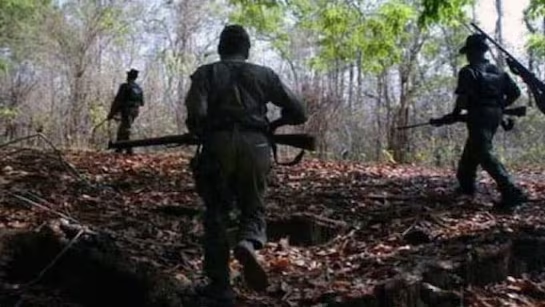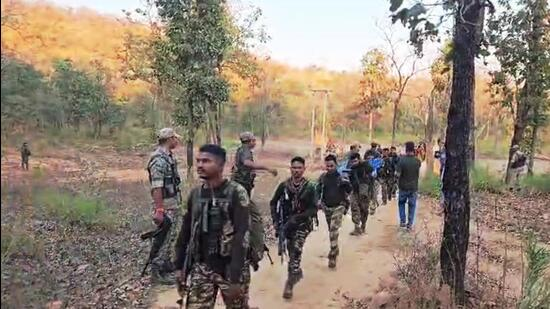
In a significant development in India’s fight against Naxal insurgency, security forces successfully neutralized 26 Naxals in a major encounter in Chhattisgarh. The operation, which took place in the dense forests of Dantewada district, marks one of the most impactful actions against the Maoist insurgents in recent years. Among those killed, authorities suspect the presence of a top Naxal leader, potentially delivering a strategic setback to the rebel group.
The Encounter: A Precision Operation
The encounter unfolded early on a fateful morning, when a joint team of the District Reserve Guard (DRG), the Special Task Force (STF), and the Central Reserve Police Force (CRPF) launched an operation based on specific intelligence inputs. Acting on a tip-off about a large gathering of Naxals, the forces moved cautiously through the rugged terrain, which is notorious for ambushes and booby traps.
Upon reaching the target area, the troops were met with heavy gunfire, initiating a fierce exchange that lasted several hours. Despite the challenging conditions and the hostile environment, the forces managed to outmaneuver the insurgents. By the end of the operation, 26 Naxals lay dead, and a substantial cache of arms and ammunition was recovered. This included sophisticated weaponry, improvised explosive devices (IEDs), and key documents, which could provide further insights into the Naxal strategy.
Chhattisgarh: The Heart of the Naxal Conflict
Chhattisgarh has long been the epicenter of India’s Naxal insurgency, which spans several states and has persisted for decades. The Maoist movement, rooted in left-wing extremism, has been a source of violence and disruption in rural and tribal areas. While the insurgents claim to fight for the rights of marginalized communities, their tactics—which often include attacks on civilians, security personnel, and infrastructure—have drawn widespread condemnation.
The state’s dense forests and challenging topography provide the perfect cover for Naxal groups, making counter-insurgency operations extremely difficult. These forests not only serve as their hideouts but also as their training grounds. Over the years, the Naxals have established an extensive network of underground bunkers, supply routes, and communication systems, making them a formidable adversary.
A Potential Leadership Vacuum
Among the 26 slain Naxals, authorities suspect the presence of a top-ranking leader. While the identity has not been officially confirmed, preliminary reports suggest it could be one of the group’s strategic masterminds. If true, this development could create a leadership vacuum within the organization, potentially weakening its operational capabilities.
Top Naxal leaders have long been the focus of security forces, as their elimination can disrupt the command-and-control structure of the insurgency. Over the years, targeted operations have significantly reduced the influence of key leaders, and this latest encounter may add to that tally. This operation has also heightened the morale of security forces, boosting confidence in their ability to dismantle the insurgency.
Voices from the Ground
Local residents in Dantewada have expressed a mix of relief and apprehension following the encounter. While many welcome the action as a step toward peace, others fear retaliatory attacks by the Naxals. The region has often witnessed brutal reprisals following major operations, highlighting the complex dynamics of the conflict.
One local villager, who requested anonymity, said, “We hope this will bring some relief, but we are always on edge. The Naxals have been here for decades, and their retaliation can be swift and ruthless.” Another resident emphasized the need for sustained government presence in the area to prevent the insurgents from regrouping.
The Human Cost of Insurgency
The Naxal insurgency has exacted a heavy toll on both security forces and civilians. Thousands have lost their lives, and countless others have been displaced from their homes. Tribal communities, in particular, have borne the brunt of the violence, caught between the insurgents and the state.
Efforts to address the root causes of the conflict, such as poverty, lack of development, and social inequality, have been ongoing but slow. While security operations are crucial, experts emphasize the need for a holistic approach that combines military action with socio-economic development.
In addition to the loss of life, the insurgency has disrupted essential services, hindered infrastructure development, and stunted economic growth in affected regions. Schools, healthcare facilities, and roads are often targeted by Naxal groups, depriving communities of vital resources.
Strategic Implications
The successful neutralization of 26 Naxals is not just a tactical victory but also a strategic milestone in India’s counter-insurgency efforts. It sends a strong message to the insurgents and demonstrates the state’s resolve to root out extremism.
However, challenges remain. The Naxals have shown remarkable resilience over the years, adapting their strategies and regrouping after major setbacks. Security forces must remain vigilant and proactive to maintain the momentum gained from this operation.
Experts point out that the Naxals’ ability to recruit new members, particularly from disenfranchised communities, poses a significant challenge. The government’s strategy must address the socio-economic conditions that fuel this recruitment pipeline.
Political Reactions
The encounter has elicited strong reactions from political leaders across the spectrum. The Chief Minister of Chhattisgarh lauded the bravery of the security personnel, stating, “This operation reflects the dedication and courage of our forces. We are committed to bringing peace and development to all corners of the state.”
Opposition leaders, while praising the operation, have also called for increased focus on developmental initiatives to address the root causes of the insurgency. “While we applaud the efforts of our security forces, it is equally important to ensure that the people in affected areas see tangible improvements in their lives,” said a prominent opposition leader.
International Perspective

India’s battle against the Naxal insurgency has drawn attention from international observers, who view it as part of the broader global struggle against extremism. The latest operation is likely to bolster India’s reputation as a country capable of effectively addressing internal security challenges.
Experts in counter-insurgency have praised the coordination between various security agencies involved in the operation. “This encounter highlights the importance of intelligence-led operations and inter-agency collaboration,” said an analyst.
International media outlets have also highlighted the operation, underscoring its significance in the context of global counter-insurgency efforts. The successful execution of such a large-scale operation reflects the evolving capabilities of India’s security forces.
The Road Ahead
While the recent encounter is a significant achievement, it is by no means the end of the road. The Naxal insurgency is deeply entrenched, and dismantling it will require sustained efforts on multiple fronts.
Security forces will need to continue their operations while minimizing collateral damage and ensuring the safety of civilians. At the same time, the government must prioritize development projects, improve access to education and healthcare, and empower local communities to break the cycle of violence and underdevelopment.
The encounter in Dantewada serves as a stark reminder of the challenges and complexities of addressing internal security threats. It also offers hope that, with determination and a comprehensive strategy, peace and prosperity can return to regions long plagued by conflict.
Socio-Economic Solutions: The Key to Long-Term Success
While military victories like the one in Dantewada are essential, they must be complemented by robust socio-economic interventions. Experts agree that addressing the underlying issues of poverty, unemployment, and lack of basic amenities is crucial for breaking the insurgency’s grip.
Programs aimed at improving agricultural productivity, providing vocational training, and creating job opportunities can help integrate marginalized communities into the mainstream economy. Similarly, enhancing infrastructure, such as roads and telecommunications, can connect remote areas to larger markets and services.
Education is another critical area. Establishing and maintaining schools in Naxal-affected regions can help bridge the knowledge gap and offer younger generations a path away from violence. Healthcare facilities, too, must be prioritized to ensure that basic medical services are accessible to all.
Strengthening Governance and Local Leadership
Effective governance and local leadership play a pivotal role in counter-insurgency efforts. Empowering local governments and ensuring that resources reach the grassroots level can help build trust between the state and its citizens. Transparent and accountable administration can address grievances and reduce the appeal of extremist ideologies.
Community policing initiatives, where local residents work alongside security forces, have shown promise in building rapport and gathering actionable intelligence. Such programs can also serve as a deterrent to insurgent activities, as they involve the community in maintaining law and order.
Balancing Security and Development
Striking the right balance between security measures and developmental initiatives is critical. While the use of force is necessary to neutralize immediate threats, it must be accompanied by efforts to win the hearts and minds of the affected population.
The government’s Integrated Action Plan (IAP), which focuses on providing essential services and infrastructure in conflict zones, is a step in the right direction. However, its implementation must be expedited and closely monitored to ensure tangible results.
Conclusion: A Turning Point in the Fight Against Naxalism
The encounter in Dantewada represents a significant turning point in India’s fight against Naxalism. It highlights the progress made by security forces and underscores the importance of intelligence-led operations. However, lasting peace can only be achieved through a combination of military action, socio-economic development, and good governance.
As the nation reflects on this victory, it must also renew its commitment to addressing the root causes of insurgency. By empowering communities, strengthening institutions, and fostering development, India can pave the way for a future free from the shadow of extremism. The journey is long and fraught with challenges, but the recent operation offers a glimpse of hope and a roadmap for what lies ahead.

